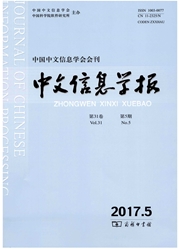

 中文摘要:
中文摘要:
该文提出基于Word Embedding的歧义词多个义项语义表示方法,实现基于知识库的无监督字母缩略术语消歧.方法分两步聚类,首先采用显著相似聚类获得高置信度类簇,构造带有语义标签的文档集作为训练数据.利用该数据训练多份Word Embedding模型,以余弦相似度均值表示两个词之间的语义关系.在第二步聚类时,提出使用特征词扩展和语义线性加权来提高歧义分辨能力,提高消歧性能.该方法根据语义相似度扩展待消歧文档的特征词集合,挖掘聚类文档中缺失的语义信息,并使用语义相似度对特征词权重进行线性加权.针对25个多义缩略术语的消歧实验显示,特征词扩展使系统F值提高约4%,使用语义线性加权后F值再提高约2%,达到89.40%.
 英文摘要:
英文摘要:
This paper introduces a knowledge based unsupervised method for acronym term disambiguation. Word embedding is used for acronym term semantic representation. In the first stage of disambiguation, significantly similar documents are clustered and used as training data. Each cluster corresponds to an interpretation of an acronym term, so it can be seen as a semantic tag. Then the word embedding is trained for several times and semantic relation between two words can be calculated by average of cosine similarity of their vectors. In the second stage, the paper proposes to use feature word expansion and linear weighted semantic similarity to improve system performance. By calculating semantic similarities between documents and interpretations, implicit semantics can be mined as new feature words; and the feature words are linearly weighted by their semantic similarities with specific interpretation. Experimental results on 25 acronym terms show that, feature word expansion improves system F score by 4% and semantic weight gains higher performance by 2%, which yielding a final system F score of 89.40%.
 同期刊论文项目
同期刊论文项目
 同项目期刊论文
同项目期刊论文
 期刊信息
期刊信息
